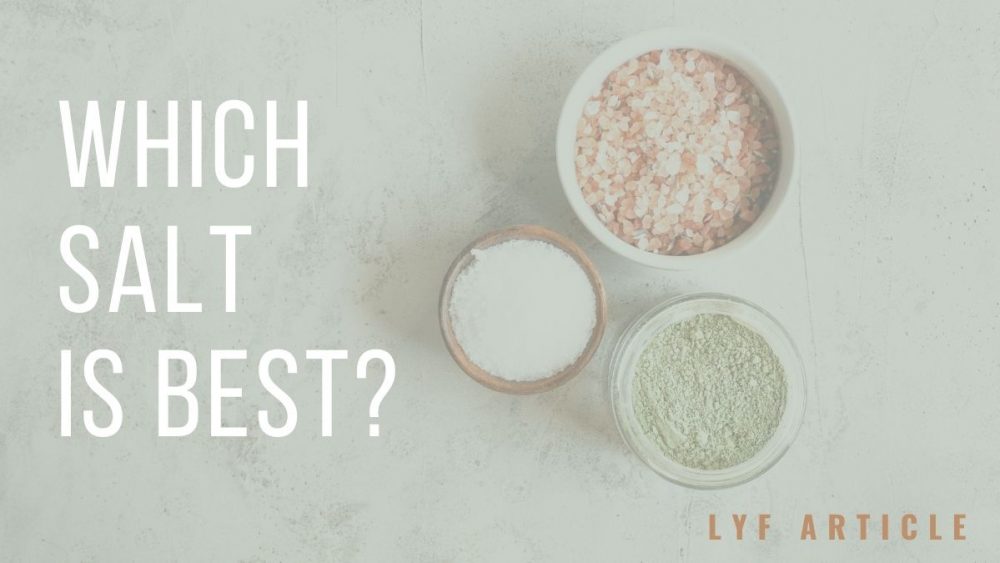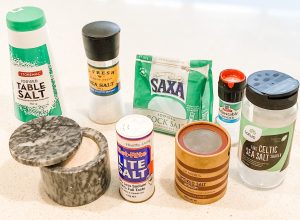People always ask what salt we recommend, and what salt is best?
Short answer: The one you have.
Long Answer: The one your body likes/wants. Or Celtic Sea Salt.
As you can see from the photo above, we like to keep a variety of salt in the house for different occasions, different tastes, and different health benefits. However, we don’t always have this many salts, whilst other times we might have even more varieties!
Which one to choose will simply depend on which one is handiest (the closest to hand). Other times it will be for flavour. Occasionally I will put health benefits first, such as choosing the “Lite Salt” for some of my water bottles as it has extra potassium for when I’m sweating and moving lots, if I feel i haven’t supplemented with potassium much lately. That is about as technical as I get.
Let’s start at the back left in the picture, the big one, then we’ll continue in a clockwise direction.
Iodised Table salt.
Super cheap, this one is from Aldi. Iodine is crucial. If you ate a diet devoid of iodine it can cause all sorts of issues. Iodine is important for pregnant (and pre-pregnancy) women and throughout gestation, as well as in early years of a child’s development.
Sea Salt in a Grinder
This is a good one for guests to use at the dinner table, easy to portion, nice flavour profile. We probably need to get a nicer grinder haha.
Saxa Iodised Rock Salt
Good to refill grinders with and sneak in the iodine, or sprinkle over food before cooking for a crunch and hit of salt in some bites.
Another non reusable grinder
We are just using it up until it is empty.
Celtic Sea Salt
Probably the best salt. It is not as refined, hence why it is slightly damp and not super fine. It has the best mineral profile (Sodium 34 grams, Calcium 287 mg, Potassium 109 mg, Magnesium 34 mg, Iron 11 mg, Manganese 1 mg, Zinc 0.35 mg). It has a good flavour too. We usually buy in bulk from “The Source” store, and refill this easy pour/sprinkle container.
Smoked Salt.
Redgum scented smoked salt. This is a delicate rock salt. My favourite to sprinkle over raw marrow (that may not be how you choose to use it, haha). A balanced strong flavour with a little crunch and bite. I’ll buy this again when it runs out. I love it.
Lite Salt
Lower sodium (which is a not a benefit for most of the population), but 50% of the sodium is replaced by Potassium Chloride so you can get some potassium in your diet! Potassium is a great electrolyte, this is an easy way to make sure you get some in your diet to help replace the potassium lost/used in sweat and energy production. Use in drink bottles as you like.
A second Smoked Salt
This smoked salt is a finer grain, and much “smokier” than the flavours of the Redgum salt. It was also cheaper, from a market a few weeks ago, it adds a bit of depth to a slow cooked dish, a steak rub, or anything else you like to experiment with.
Bottom line is to have a few different salts so you use them more, get different flavours in your food, and different minerals in your body. You’ll notice we don’t have a plain Pink Himalayan salt, there is no particular reason other than we buy the celtic salt in preference for it’s slightly better mineral profile and “less refined” process of creating the end product. Celtic salt also absorbs into water significantly more than Himalayan salt.
And yes, we could be using an Australian salt for less “food miles” (celtic salt comes from France), we just haven’t bought one lately plus we go through so much salt (really, tonnes) it needs to be comparable in price for us to use as a salt for our daily meals.
Hope this has given you some ideas of how to use different salts, and what else you can do for your health,
performance, and happiness.
*See below for some technical/practical information on Sodium and Salt.
All the best
Pete
SODIUM (Sodium Chloride)
Sodium is a strong mineral that promotes hydration, combined with a minimal form of sugar (fructose, glucose, sucrose), it is the perfect hydrating solution. In fact, plain water is not optium to hydrate you…..hence combining a touch of honey/apple or orange juice/ or coconut water with a pinch of sodium to your water bottles.
Sodium is the main electrolyte found in your blood, playing a number of important roles in the body.
It helps;
- Maintain a fluid balance in your body.
- Absorbs and retains more of the fluid you take in. This boosts your blood plasma volume.
Key Points
- Everyone has different sodium requirements depending on physiological make up, sweat rate and hormonal balance.
- If you are transitioning from a high carb diet to a low carb diet it is recommended to take 1-2 teaspoons per day, more if sweating daily.
- Take with water and add with magnesium supplementation. Or ‘shot’ ¼ tsp with squeeze of lemon and water when needing extra.
- If fat adapted, and eating lots of protein, salt may not be needed in large quantities outside of electrolyte drinks during exercise.
- The good news is that excess salt will only result in excess urination, and has no side effects (except for the small percentage of sodium sensitive population). Experiment & talk to us, we will help find what’s right for you.
Did You Know?
On long warm training days you can lose around half a teaspoon of salt (1.1 gram sodium) per hour, so 5hrs of training requires approx 2.5 teaspoons of salt.
An average healthy man or women contains around 7000-9000mg of sodium in the body. One third is found in healthy bones, with the remaining two thirds surrounding cells throughout the body where sodium is a major player in cell regulation. It is common to see people suffering adrenal fatigue or burn out lacking in sodium.
Sodium also helps regulate the Ph balance, water balance, heartbeat, and other muscle contractions. It helps regulate sugar metabolism, and blood pressure balance.
Sodium is the main electrolyte found in your blood, playing a number of important roles in the body. It helps maintain a fluid balance in your body, plus absorb and retain more of the fluid you take in. This boosts your blood plasma volume, very important during the high hormone phase of a menstrual cycle and high energy demand, high stress output scenarios.
Approximately 30% of those with high blood pressure will be sodium sensitive. Best to consult your doctor as even a moderate amount of salt may increase blood pressure.


